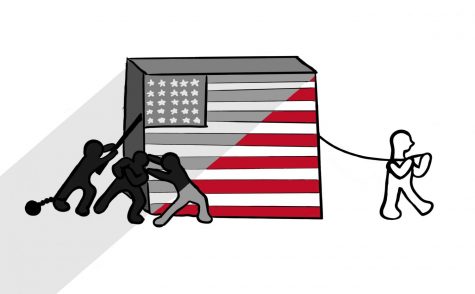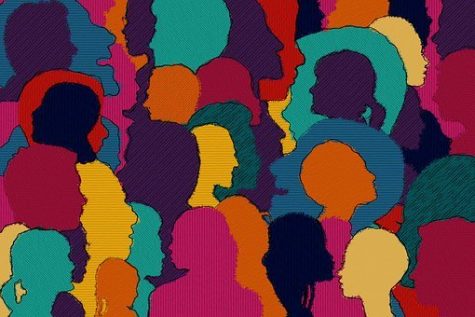The Irony of an American Orwell
April 22, 2022
Introduction: The Birth of Saint Orwell
When a casual onlooker takes a moment to step away from engaging with the immense sphere of bent and broken arguments which stretch themselves thin across the endless bowels of social media and looks upon what comprises the abandoned battlefield filled with the remains of misquotations and poorly presented statistics, they will find a strange commonality which seems to bind the apparent chaos into a more tangible whole.
A proclaimed fight against totalitarianism and authoritarianism arises, and the mad dash to see who can get to the dictionary definition of autonomy first rears its ugly head and sneers at those who have their preconceived notions of the free self seems to layer the tracks of liberal discourse. The self-identified “progressive liberals” point to obvious examples of violence and attacks upon minorities by extremist individuals and the “conservatives” will go on to whinge about the state of modern discourse, the supposed libral domination of the media, and apparently tyrannical threat of “cancel culture” and political correctness. And in their depiction of the liberal endtimes brought upon by respecting trans and non-binary identity as well as a lack of racist cariactures in school libraries, they seem to return to a prophet, all of whom hail as a saint of this liberal antithesis of the “The West”, Orwell.
Indeed, it is the works of Orwell the American Neo-conservative movement has chosen to embody the dangers of social progressivism, and the manner of social campaigning and protest by which such environments of tolerance and to some extent acceptance are cultivated by1. Thus the obvious question which arises from such an observation is as to why specifically Orwell and his magnum opus are cited as the primary vision of the perceived American Dystopia. Why not other purveyors of the totalitarian model of society such as Huxley and from a more contemporary standpoint, Atwood, or if one wishes to navigate the obscure, Burroughs or Burgess. In fact the point of comparison with Orwell’s cohort Huxley, may lead us to the answer as to why Orwell has become canonized in western media as the patron saint of tyrannical fiction. For the two, despite their focus upon the same fundamental idea, the ultimate repression of a people by their state, they find themselves observing the methods of subjugation in highly contrasting manners of exploration.
There are two major and distinct characteristics that form the fictional model of a dystopia, and in turn, create the tension between a Brave New World (Huxley’s dystopia) and 1984 (Orwell’s), and those are the frameworks of political oppression by which their protagonists are restricted and the aesthetic that arises from said repression. To explore the aesthetic nature of each work, let us first analyze the nature of our introduction to each dystopia. 1984 opens as such.
The hallway smelt of boiled cabbage and old rag mats. At one end of it a colored poster, too large for indoor display and been tacked to the wall. It simply depicted an enormous face, more than a meter wide: the face of a man of about forty five, with a heavy black mustache and rugged features. Winston made for the stairs. It was no use trying the lift. Even at the best of times it was seldom working, and at present the electric current was cut off at daylight hours. It was part of the economy drive in preparation for Hate Week. The flat was seven flights up, and Winston, who was thirty-nine, and had a varicose ankle above his right ankle, went slowly resting several times on the way. On each landing, opposite the lift shaft, the poster with the enormous face gazed from the wall. It was one of those pictures which are so contrived that the eyes follow you when you move. BIG BROTHER IS WATCHING YOU, the caption beneath it ran. — From 1984, pp. 1-2
There is an instant image of greyness and dilapidation that Orwell conjures in the mind of the audience, a uniformity which seems to us alien through the contradiction of the environment’s simultaneous presentation of rigid structure and constant decay. The audience is treated to what is undoubtedly a building steeped in it’s decline, and proliferated with the stench of poverty. Winston as well as his residence is lowly, insignificant in the face of the state which watches over him and the rest of the people who live in his apartment. Not only is the building shown to be collapsing under disregard and disrepair, but so is Winston, maybe even as a result of the conditions in which he lives. He is in pain as a result of his ulcer and his ulcer is left unaccounted for as a result of his presumably rancid living conditions as well as the power cut off for “Hate Week”. It is here established that the building, and all other facets of organization are handled purely by the state, and that in turn, the state does not care for the individual, the only true contribution of the state in this passage, is a simple reminder to Winston that it looms over every aspect of his existence. The effect is immediate and present to the reader, alienation, confusion, dread, all seen as Winston’s existence within the confines of the drab and declining apartment he lives in sets the stage for what is soon to be explored as Winston begins to confront the seemingly incomprehensible entity that is Big Brother. And indeed the state, the party, Big Brother, whatever you wish to refer to the state apparatus of 1984 as, is shown to instill paranoia in those who are subjected to its authority, the spaces it provides are cramped and poorly run with nothing in the way of comforts or utilities to maintain the people who live there, just a constant and total reminder that they are being monitored through a design which intentionally provokes from it’s reader an immediate feeling of being watched, not simply from a far but from every corner of their surroundings, for they are surrounded by that constant reassurance. Big Brother makes itself a phantom, an abstraction, something intangible by way of its immense power and presence, Big Brother isn’t merely the state apparatus but the idea of its influence, the idea of its danger, and the idea of its control over the populace, by design. In other words Big Brother is the totality of the world in which one resides, to exist is to be of Big Brother. The party in 1984 does not intend to trick its populace into believing it is of no threat to them, its deception does not lie in such maneuvers nor should its deception lie in attempting to cover its oppressive nature, the overt display of absolute authority is an intentional property of the propaganda that Big Brother uses in continually repressing its populace, by making repression and the danger of opposition the normal condition, and by extension, making any defiant action entirely futile as an isolated individual.
Furthermore this scene elucidates the tendency of abandonment within Oceania’s society. For Winston and by implication the rest of the citizenry living within the apartment are left to toil within this corner of degraded space that they have been given, beyond this initial exchange of security and power however, Big Brother pays no attention to them, for they are but pieces of a far larger system. Their only importance, in the eyes of Big Brother, lies in the fact that they maintain the machine that is Oceania, that is why posters with his visage watch over them. He is not a guide or a caretaker, but a warden, a conductor of the great machine which is pieced together by the poor sods he leaves to succumb to illness and poverty. The preservation of the individual, their health, their happiness, their sense of being or recognition has withered away, and what has taken its place is the importance of being a component.
It is in this manner that the individual becomes entirely meaningless for their actions find no manifestation within 1984’s society other than erasure, it is thus then that the alternative presented is the collective, it is not that the collective presents liberation, again, liberation and freedom are not an illusion that the party wish to cast, instead the party elects to present itself, as well as its spirit of singular collectivism, as a necessity. Orwell’s dystopia is explicit in it’s aesthetic of oppression and dilapidation, for above all else it simultaneously alienates the self from and draws the self into the absolute that the state presents. This is the power of Orwell’s dystopia, it is unabashedly a dystopia, it hides not behind shades of prosperity to lure readers and then quickly clench it’s literary jaws upon them to demonstrate the slight of hand which utopian fiction so commonly employs, no it lays itself out as a danger, bearing its teeth to the audience. 1984 thoroughly stirs in its own misery from beginning to end, and it is in the deprivation and alienation of the individual and their power from which such misery originates, and within the constant pairing of misery and the destruction of the individual we find the aesthetic of the Orwellian dystopia.
So now we bring ourselves to the advent of Huxley’s dystopia, and its aesthetic. Brave New World begins as such.
A squat, grey building of only thirty four stories. Over the main entrance the words, CENTRAL LONDON HATCHERY AND CONDITIONING CENTER, and, in a shield, the World’s State motto, COMMUNITY, IDENTITY, STABILITY. The enormous room on the ground floor faced towards the north. Cold for all the summer beyond the panes, for all the tropical heat of the room itself, a harsh thin light glared through the windows, hungrily seeking some draped lay figure, some pallid shape of academic goose-flesh, but finding only the glass and nickel and bleakly shining porcelain of a laboratory. Wintriness responded to wintriness. The overalls of the workers were white, their hands gloved with a pale corpse-coloured rubber. The light was frozen, dead, a ghost. Only from the yellow barrels of the microscopes did it borrow a certain rich and living substance, lying along the polished tubes like butter, streak after luscious streak in long recession down the work tables.”
— From Aldous Huxley's Brave New World, pp. 1-2
Even upon initial reading, the opening of Brave New World draws itself into sharp contrast with the overbearing dilapidation of 1984. Although it possesses in itself a form of alienation, it doesn’t appear as the great monolith of forceful totality with which the victory mansions present themselves, it rather far more subtle, present, but hidden, cloaked in a mirage of fine silk. And yet it exposes its own alienation. Not through the grand spectacle of induced isolation, or the theatrics of totality, but rather through very slight contradictions, perhaps best exemplified in Hitchcock’s notion of the icebox, in which an audience member is to quickly notice the true nature of how bizarre an incident is only when they are given time to reflect, when they are able to contemplate the devices used to present incident as opposed to simply view them. It is this contemplative rhythm which characterizes Brave New World’s broader aesthetic, that is a thoroughly sterile one. For the lab, as it is described is just that, a lab, it seems to possess no true humanity, no form of light or warmth, save for that which emanates from the tubes in the work station, and even those factors which usually bring a vibrant life to a space, it’s lighting, shape, and those who occupy it, are coated in a rather undead-malaise, neither deceased and rotting, nor truly alive, however despite this unnerving atmosphere it still presents to the reader the comfort of cleanliness, order, and stability. This state apparatus appears not to thrust upon its subjects the notion of collectivisation as the only option, but rather a gentle reassurance, a community, not a prison. And indeed this is where the core of Huxley’s power lies in the creation of his dystopia, it is not explicitly confrontational, it does not explicate on the nature of its own terror be it through the depiction of the society itself or by way of a third person narrator, but rather allows for the thought of the audience to guide them through the true horror of the image of total peace and stability which envelopes Brave New World, that being order and satisfaction at the cost of the universality of human experience which gives such ideals meaning and worth, it is a utopia bound not in misery, but the overexposure of enjoyment, it does not impress itself upon the individual but numbs them through the course of absolute stability. As such it becomes a far harder subject to extrapolate when one speaks upon freedoms restrictions in a purely rhetorical context, for it gives way to contradiction, and obvious contradiction at that, for it is the simultaneous liberation of the individual from the chains of the collective but the reappropriation of the individual by way of providing desire. As such the aesthetics of Brave New World finds itself not in an absence of freedom by way of a misery imposed upon the subject, but rather the subject finding themselves bound to the comforts of an ordered society, bound to a utopia. It is indeed unnerving and by all accounts uncanny but no such a broad extension of the totalitarian absolute so as to remove the illusion of control in it’s entirety.
However, to truly confirm my theory on the nature of each dystopia’s aesthetics constituting the broader reasoning behind the flagrant use of one in discourse over the other, let us look upon an example of 1984 as an ideological polemic. The following is a written by Majorie Taylor Greene as a response to the following New York Times piece,https://t.co/A2oLMzaUnK , which concerns the resultant arrest and prosecution of a number of individuals who participated in the January 6th coup, proposing that apps were used to track those various individuals. Said Greene of the article “It’s 1984 and back then we didn’t have cell phones. Remember?”.
The use of the dystopia in discourse focuses upon its aesthetic, however it is not the aesthetic of it’s transformation into such a society, but rather the society itself. Process is discarded as the concern for those who paddle about the shallow end of peering into the notions of dystopia, rather elect to focus merely upon the avoidance of its result, that being dystopia itself. And even when one appears to observe within politics a factor which could proliferate into such a form of dystopia, the critique which they level at such occurrences is not one of the contents of the action but rather it’s optics. (This focus upon the optics of the process will be discussed later see “What is Orwellian?” And “What is (really) Orwellian?”) Most rhetorical uses of 1984 present it not as an oncoming tide of totalitarianism, but rather as the current state of being or a present and definite reality. It is in such a statement that the implication of resistance occurs, for we are already in the authoritarian regime and as such any form of presented resistance is justified.
It is with this assessment of Orwell’s aesthetic that we return to his transformation into a cultural prophet, a societally motivated deity. The easy answer would be to say that his image of collapse and dystopia is powerful, and by all accounts, one can agree with such a statement. However when one makes reference to his dystopia, they do not simply proclaim it to be of the spirit of 1984, but Orwellian, that is to say that something is of Orwell. It is the unfortunate result of this misconstruction of Orwell’s essence by way of the rhetorical use of his external representation, which causes us to require careful treading about defining what it means to be of Orwell. As such we must distinguish and analyze two categories of reference to Orwell, that being the manner of reference in popular culture and the content of his works within their own context. In other words we must peer into a dichotomy of the Orwellian, Orwell and his works as they were and are, and Orwell and his works as they are represented, or as I wish to term this identity of Orwell and his catalogue, perhaps out of a sense of irony or simply as a fun if not cynically motivated naming convention, Saint Orwell










